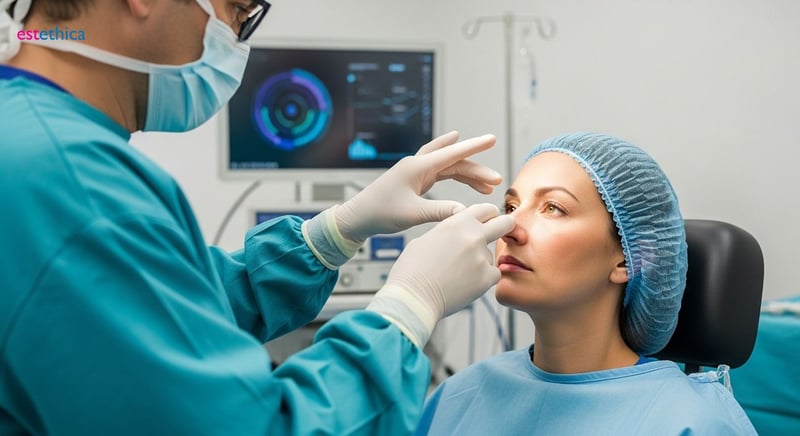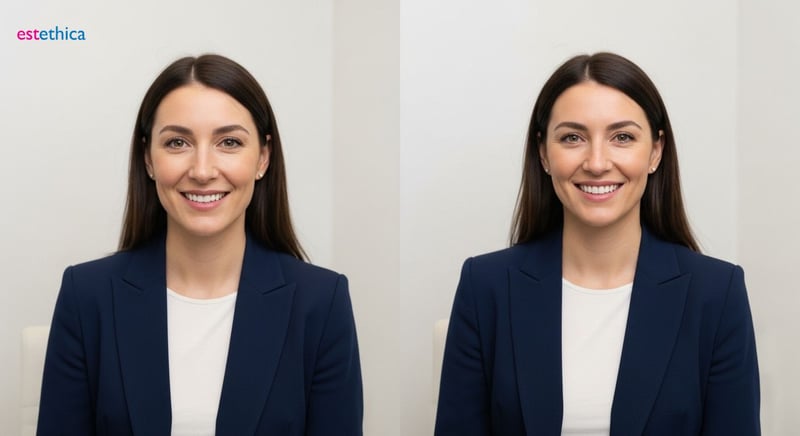Reshape Your Story: Exploring the Art of Nose Surgery
Uncover the benefits of nose surgery and how it can transform both appearance and breath, sculpting confidence with each new inhale.
Nose surgery, often referred to as rhinoplasty, is more than just a cosmetic procedure; it's a gateway to enhanced self-esteem and improved respiratory health. With a growing emphasis on aesthetic appeal and functional benefits, rhinoplasty has seen a surge in popularity. This comprehensive guide explores the nuances of nose surgery, ensuring you are well-informed on your journey to sculpting confidence, one breath at a time.
Rhinoplasty Unveiled: Understanding the Procedure & Its Goals
Exploring Rhinoplasty Techniques and Approaches
Rhinoplasty encompasses a variety of techniques tailored to meet individual patient needs and desired outcomes. From addressing breathing issues to refining the shape of the nose, understanding these approaches is crucial. Skilled surgeons often use advanced imaging to plan procedures, aiming for results that enhance both aesthetics and functionality. Rhinoplasty is more than a cosmetic fix; it's a personalized procedure designed to improve overall quality of life.
- Open Rhinoplasty: This approach involves a small incision across the columella, allowing the surgeon greater access to reshape the underlying bone and cartilage for significant corrections.
- Closed Rhinoplasty: Performed entirely through the nostrils, this technique minimizes external scarring and is ideal for less complex adjustments to the nasal structure.
- Liquid Nose Job: A non-surgical option using injectable fillers to temporarily reshape the nose, best suited for minor corrections and enhancements without downtime.
Each method has its own advantages, making a detailed consultation with a qualified surgeon essential to determine the most suitable option. In fact, about 30% of rhinoplasty patients seek the procedure to correct breathing difficulties, in addition to aesthetic improvements.
Setting Realistic Expectations for Rhinoplasty Outcomes
Achieving satisfaction with a rhinoplasty requires clear communication and realistic expectations. It's important to understand that while surgery can significantly improve the appearance and function of the nose, the final result is influenced by individual factors such as skin type and healing ability. Rhinoplasty aims to create harmony between the nose and other facial features, enhancing overall beauty while maintaining a natural look. Rhinoplasty, including ethnic rhinoplasty, is a personalized procedure with the goal of enhancing beauty and maintaining a natural appearance.
- Consultation and Planning: Discuss your goals and concerns with the surgeon, who will assess your nasal structure and provide a realistic picture of potential outcomes.
- Understanding Limitations: Recognize that rhinoplasty can't create a "perfect" nose but can significantly improve balance and proportion in line with your facial features.
- Post-operative Care: Follow your surgeon's instructions carefully to ensure proper healing and minimize complications, which is essential for achieving the best possible results.
For example, a patient with thick nasal skin may experience a more subtle refinement compared to someone with thinner skin. Approximately 85% of patients who undergo rhinoplasty report satisfaction with their results, highlighting the importance of aligning expectations with the achievable outcomes.

Finding Your Ideal Surgeon: Essential Qualities & Expertise
Essential Steps to Verify Surgeon Credentials and Expertise
Selecting the right surgeon for a nose surgery involves careful verification of their credentials and a thorough assessment of their expertise. Start by confirming board certification in plastic surgery, which ensures that the surgeon has met rigorous standards of education, training, and competence. Specialized experience in rhinoplasty is also essential, as this indicates a focused skill set in nasal procedures. An experienced surgeon will have a comprehensive portfolio of before-and-after photos that showcase their work and demonstrate their ability to achieve aesthetically pleasing and functional results. This review process is critical in determining if the surgeon's aesthetic aligns with your personal goals for the nose job or nose surgery.
- Check Board Certifications: Ensure the surgeon is certified by the American Board of Plastic Surgery to confirm their qualifications.
- Review Before-and-After Photos: Evaluate the surgeon's past work to assess their aesthetic style and success rates.
- Inquire About Rhinoplasty Experience: Determine how frequently the surgeon performs nose surgery and their specific expertise in this area.
Building Trust and Rapport Through Open Communication
Establishing a strong rapport and trust with your surgeon is vital for a successful surgical experience. During consultations, the surgeon should communicate openly about all aspects of the procedure, including potential risks, the expected recovery timeline, and a detailed overview of what the surgery entails. Personalized advice tailored to your specific needs and concerns is crucial. Patient reviews and word-of-mouth recommendations can provide valuable insights into the surgeon's bedside manner, communication style, and overall patient satisfaction. This collaborative approach ensures that both you and the surgeon are aligned on the goals and expectations for your rhinoplasty. Understanding the nuances of procedures like a liquid nose job and discussing whether a non surgical nose job cost is a viable option for your aesthetic goals is important.
- Comprehensive Consultation: Engage in detailed discussions about your goals, concerns, and expectations for the procedure.
- Review Patient Testimonials: Research patient reviews to gauge the surgeon's communication style and patient satisfaction.
- Discuss Recovery and Risks: Ensure you have a clear understanding of the recovery process and potential complications associated with the surgery.

Beyond Aesthetics: Exploring Functional Benefits of Nasal Surgery
Unveiling the Health Advantages of Rhinoplasty and Septoplasty
Beyond the cosmetic enhancements, a nose job and related procedures like septoplasty offer substantial health benefits, particularly for individuals with nasal obstructions or deviated septums. These structural issues often lead to impaired airflow, causing chronic breathing difficulties that can significantly diminish one’s quality of life. Rhinoplasty, when performed to correct these problems, facilitates improved nasal function, allowing for easier and more efficient breathing. This is particularly beneficial for those who experience discomfort or difficulty breathing through their nose, enhancing their overall respiratory health and well-being. Nasal surgery can be a transformative solution, addressing both aesthetic concerns and underlying functional issues.
- Improved Airflow: Corrects structural issues like deviated septums, enhancing nasal breathing.
- Reduced Breathing Problems: Alleviates chronic nasal congestion and obstruction.
- Enhanced Quality of Life: Facilitates better sleep and physical activity by improving respiratory function.
How Functional Nasal Surgery Can Alleviate Breathing Disorders
Septoplasty, often combined with rhinoplasty, specifically targets structural irregularities within the nose to enhance its functionality. By correcting these issues, the surgery can alleviate symptoms associated with sleep apnea and other breathing disorders, leading to a noticeable improvement in the patient’s daily life. For instance, individuals who undergo nasal reconstruction to correct a collapsed nasal valve often experience a significant reduction in snoring and improved sleep quality. Furthermore, a well-executed rhinoplasty can restore or augment nasal function while enhancing aesthetic appeal, making it a dual-purpose procedure with potentially life-changing benefits. Many patients find that after undergoing nasal surgery, their ability to engage in physical activities improves due to better oxygen intake, underscoring the profound impact of these procedures.
- Diagnosis and Assessment: Comprehensive evaluation to identify structural issues causing breathing difficulties.
- Surgical Correction: Precise adjustments to the nasal septum and other structures to improve airflow.
- Post-operative Care: Detailed guidance to ensure proper healing and optimal functional outcomes.

Nose Job Recovery: A Comprehensive Guide to Healing and Results
Navigating the Initial Weeks After Nose Surgery
The immediate aftermath of a nose job involves a period of careful management to ensure optimal healing. Typically, the initial recovery phase spans one to two weeks, during which swelling and bruising are most pronounced. Patients are advised to keep their head elevated, even while sleeping, to minimize swelling. During this time, it's crucial to adhere strictly to the surgeon's post-operative guidelines, which may include regular cleaning of incisions and taking prescribed medications to prevent infection and manage pain. Avoiding strenuous activities is also paramount to prevent any accidental trauma to the healing nasal structures. Rhinoplasty results in noticeable improvements, but the journey requires patience and diligence.
- Head Elevation: Sleeping with your head elevated helps reduce swelling and discomfort.
- Gentle Cleaning: Regular, gentle cleaning of incisions prevents infection and promotes healing.
- Activity Restriction: Avoiding strenuous activities minimizes the risk of complications during recovery.
Long-Term Care and Maximizing Rhinoplasty Results
Achieving the best possible outcome from a nose job extends beyond the initial recovery period, requiring ongoing care and attention. Protecting the skin from sun exposure is vital, as UV damage can impede healing and affect the final appearance. Regular follow-up appointments with your surgeon are essential to monitor progress and address any concerns that may arise. Maintaining realistic expectations is also key, as the final results of the rhinoplasty may take several months to fully manifest. The subtle refinements achieved through procedures like a closed rhinoplasty continue to improve over time, making patience an important virtue. Nasal reconstruction ensures long-term satisfaction with both the aesthetic and functional outcomes of the surgery.
- Sun Protection: Consistent use of sunscreen protects sensitive skin and ensures optimal healing.
- Follow-Up Visits: Regular check-ups allow your surgeon to monitor progress and address any issues.
- Patience and Realism: Understanding that final results take time to fully materialize helps manage expectations.
Advanced Rhinoplasty Techniques: Open, Closed, and Non-Surgical Liquid Nose Jobs
Comprehensive Rhinoplasty Recovery and Long-Term Care for Optimal Results
Frequently Asked Questions
What is rhinoplasty and what does nose surgery involve?
How does septoplasty differ from rhinoplasty, and when is each procedure recommended?
What are the different types of rhinoplasty techniques available?
What factors affect rhinoplasty cost, and what should I consider when budgeting for nose surgery?
What does the recovery process entail after nasal surgery or a nose job?
Ready to discover your healthiest, most beautiful self with estethica's personalized care?
📞 Call Now for a Free Consultation!